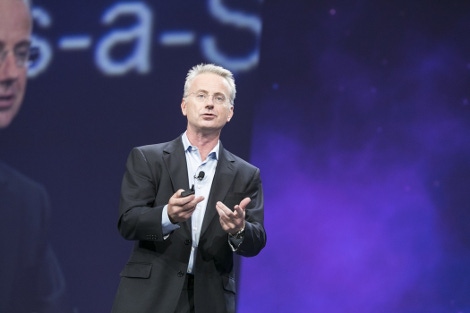Report: AWS, VMware Lead Enterprise Cloud, But Shakeup is PossibleReport: AWS, VMware Lead Enterprise Cloud, But Shakeup is Possible
Analyst reports show competitors gaining ground on leaders in the space
April 16, 2015

A pair of recently published 451 Research cloud reports - the Vendor Window and Microsoft-commissioned Beyond Infrastructure: Cloud 2.0 Signifies New Opportunities for Cloud Service Providers - revealed interesting trends in the cloud landscape.
The first report showed that Amazon Web Services leads the public cloud space while VMware owns the private, on-premises space. However, both vendors have competition breathing down their necks. The report, compiled for Microsoft (no sign up required), found that a bigger portion of the budget in general is being dedicated to off-premises deployment models. It also concluded that cost is not the major driver for these decisions, adding weight to those vendors scoring high marks for satisfaction in the Vendor Window report.
The noted leaders are no surprise given the head start AWS and VMware had in public, and on-premise private clouds, respectively. The most fragmented market is hosted private cloud, which saw adoption by just one-third of those surveyed. Rackspace led all hosted private cloud providers with 20 percent, but those with less than 3 percent of total market share own more than half of the total.
One-third of enterprises expect IT to spend more over the next 90 days, with the majority staying with their current cloud providers, according to the both reports.
Competitors Gaining on AWS Lead
In other results, AWS remains the leader in Infrastructure-as-a-Service (IaaS) adoption among enterprise IT buyers, but Azure is not only breathing down its neck, it was cited as the vendor enterprises will likely evaluate for their next IaaS supplier.
VMware ESX and vCloud have a 70 percent adoption rate in the enterprise, but the majority of those customers have also deployed an alternative such as OpenStack, CloudStack or Microsoft Cloud OS.
AWS is used by 57 percent of respondents, while Azure has been adopted by 42 percent. AWS achieved the highest marks for its ability to fulfill customer needs. Not to be outdone, Rackspace performed on par with AWS for its ability to fulfill customer IaaS needs and is the highest-rated IaaS provider for guaranteed SLAs, consistent with its new managed cloud positioning. However, current users of Microsoft Azure rate Rackspace lower than other vendors on the metrics of experience and support for open-source software.
"While the 2015 Vendor Window for IaaS shows Amazon Web Services as the clear leader based on multiple metrics, Microsoft Azure, Rackspace and VMware’s vCloud Air are becoming competitive challengers," said Michelle Bailey, senior vice president of Digital Infrastructure and Data Strategy for 451 Research, in a press release. "As more mainstream customers move business-critical workloads to cloud environments, the decision criteria for evaluating potential vendors change relative to early cloud adopters, and in turn, so do the vendors under consideration."
VMware Owns On-Prem Cloud
As mentioned previously, VMware dominates on-premises clouds with ESX and vCloud. The highest-rated VMware partner solution was Cisco UCS in terms of promise, fulfillment, company brand, and platform reliability.
"As open-source-based solutions continue to receive investment from major hardware and software vendors such as HP, IBM, Red Hat and Citrix, VMware’s dominance is under pressure, especially for mobile and cloud-native applications," said Dr. Scott Ottaway, vice president of cloud services and data research for 451.
Hosted Private Cloud Space Fragmented
Meanwhile, hosted private cloud is more likely to land mission critical applications than IaaS. Other than Rackspace, frequently mentioned vendors include, Verizon, CenturyLink, AT&T and VMware vCloud Air.
Move to Off-Premise Accelerating
The "Beyond Infrastructure" report also looked into overall enterprise expectations and budgeting. The fact that cloud and off-premises IT infrastructure budgets are incrementally growing while on-premises budgets are slightly shrinking, suggests a slow but not insignificant move off-site occurring in the enterprise space.
It also showed that one-third of enterprises will have 60 percent of their applications on some sort of cloud platform, with 60 percent of marketing departments already making the shift. Enterprises as a whole reported using the cloud most often for backup and recovery followed by disaster and site recovery. Database, email and business applications are moving to hosted models most often.
Global IT budgets for cloud, SaaS and things outside of corporate walls in general have gone up a few percentage points to 56. That budget is coming out of on-premises infrastructure and staff and is expected to drop from 43 to 40 percent in the next two years.
Cost is Not the Main Driver
According to “Beyond Infrastructure,” the biggest expectations when moving to outside services is gaining improved technology quality on platforms and applications (22 percent) followed by helping grow the business (18 percent). Surprisingly, speeding up time to market came in on the low end; so did cost, which makes more sense because the move to cloud is inexpensive.
The inclination to adopt off-premise services is indicative of a larger trend: IT is moving outside of corporate walls. However, the often conservative nature of enterprises means they're not looking to make wholesales shifts but hybrid ones.
In conclusion, the fact that companies are increasing spending and seeking out diversity means that the cloud market is not set in stone as AWS and VMware’s long-term dominance might suggest.
About the Author
You May Also Like







